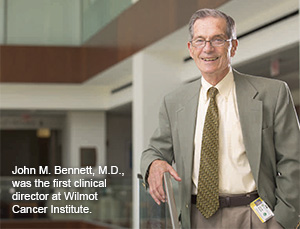An Evolution in Care
While hospitals and medical systems were developing centers that specialized in cancer during the 1970s and early ’80s, the treatments for cancer were not yet specialized.
 “We functioned in those days as complete oncologists,” says John Bennett, M.D., who was the first clinical director at Wilmot Cancer Center. “We saw a potpourri of breast cancer, lung cancer and GI cancers.”
“We functioned in those days as complete oncologists,” says John Bennett, M.D., who was the first clinical director at Wilmot Cancer Center. “We saw a potpourri of breast cancer, lung cancer and GI cancers.”
“It was pretty straightforward for me to learn to manage a breast cancer patient,” recalls Bennett, whose expertise is in leukemia. “Spin forward 20, 25 years, and that would be impossible.”
Today, it takes a multidisciplinary team to oversee an individual’s care, and the care is specific to that patient. Our focus is on precision medicine — matching the unique characteristics of an individual’s cancer with the therapies that are most effective against it. Our approach is patient-centered — involving patients more than ever in decisions about treatment and paying attention to more than the physiological aspects of the disease. Our growing involvement in clinical trials means that patients at every Wilmot Cancer Institute location have access to cutting-edge protocols.
“Ten patients with the same tumor aren’t getting the same therapy anymore,” says Carla Casulo, M.D., who came to Wilmot in 2012 and is conducting clinical trials in lymphoma.
Techniques such as gene sequencing can reveal important details about a cancer that allow doctors to clarify a diagnosis and tailor treatment. The University of Rochester Medical Center, for example, began offering HER2 FISH testing for breast cancer in 2013. This test, fluorescence in situ hybridization (FISH), measures the status of the HER2 gene, an important biomarker that can indicate how aggressive a cancer may be and whether the tumor will respond to particular targeted treatments.
New tools such as the prone breast board available at Wilmot’s Comprehensive Breast Care at Pluta and techniques such as high-dose rate brachytherapy for prostate cancer at Highland Hospital allow radiation to be delivered more precisely while protecting surrounding organs and tissues from unnecessary exposure.
These advances in treatment come with advances in understanding their side effects and considerations for quality of life. Cancer control and addressing the social and emotional impact of cancer treatment have long been an emphasis at Wilmot Cancer Institute, and they are now becoming standard parts of care.
“There is a greater awareness of how important it is to help people live better while you’re helping them live longer,” says Gary R. Morrow, Ph.D., who has been studying cancer control in Rochester since 1974 and led pioneering research on nausea and vomiting as side effects of chemotherapy.
Not only does addressing nausea, vomiting, fatigue, sleep disruption and other effects help patients, it helps their providers do more with treatment.
“They’re able to use more agents, combine agents and try things that weren’t possible when people were already far too affected by what they were doing,” Morrow says.
It is now routine to address the non-physical aspects of treatment, to include palliative care and involve the patients in decisions about treatment.
Forty years ago, patients were not such active participants in their care.
“Now we have the Patient Family Advisory Council (PFAC), and patients are such an integral part of everything we do,” says Michele Haller, R.N., B.S.N., nurse manager at Wilmot Cancer Center. Members of the PFAC, for example, provided input on the design of the rooms on the inpatient floors of the cancer center. They also tested chairs and other furniture that was selected for those units.
“They have played such an active role not only in their own treatment but in how we’ve evolved as a cancer center,” Haller says.